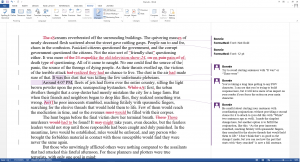I’ve alluded in previous posts to the idea that editors don’t expect authors to accept all of their suggestions, particularly in my posts on the editing process. I talked about the logistics of accepting or rejecting changes in Microsoft Word Track Changes. I’ve talked about how writing doesn’t really have rules. But after some conversations with other editors and authors lately, I realized that I need a definitive post on how to respond to editorial feedback.

Ultimately, you as an author have three options when it comes to responding to editorial feedback: you can accept the suggestion, reject the suggestion, and improve upon the suggestion. Let’s examine these three options and talk about when and how to do each one.
Rejecting Feedback
When feedback doesn’t resonate with you, reject it. You are the author. You inherently understand your book and its goals better than the editor. It comes as no surprise that sometimes you read a suggestion from your editor and think “No, that’s just wrong.” And you are entirely free to reject their suggestions. If your editor has made an in-text change, you can reject it; if they’ve made a comment you don’t agree with, you can delete it.

However, you should always give feedback a good deal of thought before rejecting it. After all, you’ve either hired this editor (presumably because you believe they are qualified to do a good job) or you’ve been assigned this editor by your publisher (who, again, chose this editor because they are qualified). You don’t want to go about rejecting out of hand suggestions given by a professional who knows what they are doing. So what should you do when you find you disagree?
Ask questions. Probably not for every small change you disagree with. But the larger the suggestion you disagree with is, the more likely your editor is going to want you to ask them questions before you dismiss the feedback. The editing and revising process should be a conversation.
This is particularly true in content editing. Ask for more details on why they made the suggestion. Perhaps with more insight into the problem, you will come to agree with their solution. Or you may find that their concern could actually be solved by making a different change somewhere else in the manuscript. Or you may simply find that you still disagree with feedback and reject it. It happens. But at least you gave the suggestion a chance.
A Note on Grammar
Rejecting suggestions gets a little more complicated when you get to corrections based on grammar. This  can happen in content editing, but will especially be the case in copy editing and proofreading. Say your editor moved or added a word, inserted a comma, or broke a long sentence in two. Some suggestions like this are primarily for word flow, and you may find you like your word flow better than the editor’s. But bear in mind that some of these small changes may actually be grammatically necessary. So don’t be surprised if you find that same correction made again later down the line. Grammar rules can be suspended on occasion in fiction, but you will probably need to discuss it with your editor or publisher.
can happen in content editing, but will especially be the case in copy editing and proofreading. Say your editor moved or added a word, inserted a comma, or broke a long sentence in two. Some suggestions like this are primarily for word flow, and you may find you like your word flow better than the editor’s. But bear in mind that some of these small changes may actually be grammatically necessary. So don’t be surprised if you find that same correction made again later down the line. Grammar rules can be suspended on occasion in fiction, but you will probably need to discuss it with your editor or publisher.
Accepting Feedback
When feedback does resonate with you, accept it. Acceptance is perhaps the easiest response to editorial feedback. You read your editor’s suggestion, it makes complete sense, and you accept it. Either by accepting the actual in-text change or by agreeing with their marginal comment and instituting the change(s) yourself.
However, just because accepting suggestions is easy doesn’t mean you shouldn’t also give a fair amount of thought to these suggestions. I sometimes get a little worried when an author tells me they loved all of my suggestions in a content edit. I definitely don’t want someone to go in to the track-changed document and just click “Accept All.”
For one thing, editors are not infallible. I can make mistakes. I can misunderstand what an author was trying to convey and thus make a suggestion that doesn’t actually make sense.
For another, an editor is not a ghostwriter. A good editor will do their best to make their suggestions fit your author voice. But sometimes your words are simply more fitting than your editor’s. This brings me to my third point.
Improving Upon Feedback
An editor’s dream is for an author to read their feedback, understand the meaning behind it, and come up with an even better solution than the editor suggested. I want my authors to improve upon my suggestions. My hope is that my suggestions and comments will help them see areas where their writing is lacking. And then they can fix the gaps in a way that fits their voice and goals for the book.
If you see a suggestion in your editor’s feedback and understand why they made the change but then think to yourself “I know what would work even better,” please do it! If your solution doesn’t quite fix the flaw, your editor can give you further suggestions. But chances are, your improvement will actually be better.
I experienced a perfect example of this recently while working on a series of fairy-tale-like short stories by Diane Nighswonger.

A Storybook Example
In one of these stories, she made what appeared to me to be a promise: A princess destined to be queen declared that queens should not be seen crying by their subjects. When she starts to cry, she shoos everyone else out of the room. Now this princess was serving as a foil for her younger sister, the protagonist of the story. So my suggestion to Diane was that we should see this younger princess be humble enough to cry in front of her subjects. I thought this would provide a nice contrast to the elder sister’s statement and resolve that promise about princesses crying.
When Diane sent me back her next draft, I found she had done something even better. Instead of making the younger sister cry, she had made the elder sister cry again later on in the story. And this time, she wasn’t ashamed. She even let someone else help her.
Not only did this take care of my concern over the unfulfilled promise, it also provided the solution to another problem I’d brought up in my suggestions. The elder sister was still left in a pride-filled limbo at the end of the story. So I suggested that Diane might want to show the completion of her character arc in the next story. But by having the elder sister humble herself in this crying scene and a few others, Diane made the princess’s character development was more complete. The ending was satisfying for both sisters.
If Diane had followed my suggestions, she would have had to rework her next story and this story would have ended with the elder sister as basically a villain. Instead, both princesses were heroes. Diane’s solution was far better than mine.
Responding to Feedback
I hope these three options will help you respond to your editorial feedback. Keep in mind that you can use these same principles in working with writing groups or beta readers. Feedback is meant to help you. But you are still in charge of your own book!
What other questions do you have about responding to feedback? Comment below and give me feedback of my own!

